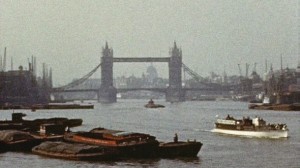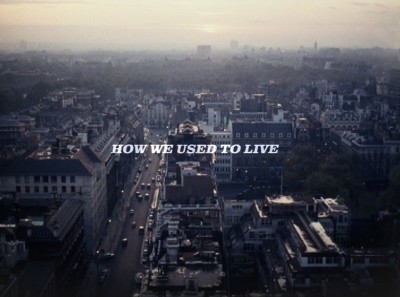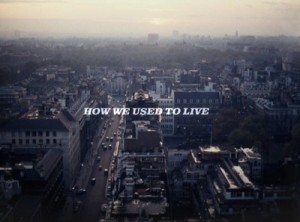DOCUMENTARY: How We Used to Live [2013, Dir. Paul Kelly]
WORDS: Gareth E. Rees
“Whenever you go down the roads in Britain, you travel not in three dimensions but four. The fourth dimension is the past. And as we move to and fro in this fourth dimension, we see not only landscape but the economic, political and social forces at work behind the landscape… shaping it, forever changing it…”
How We Used to Live is a time-travel ode to London: a head-rush of BFI clips that takes you spinning from the end of the Second World War to the early ’80s and the transformation of the docklands, via a myriad cultural and industrial revolutions.
This film collage is the latest in a series of London works by director Paul Kelly and St Etienne’s Pete Wiggs, including Finisterre, What Have You Done Today Mervyn Day and This is Tomorrow.
The pace is set by Wiggs’ fluid soundtrack, embracing lounge, library music, exotica, swing, jazz, electronica and pop. Like Philip Glass’s work in Koyaanisqatsi, the music carries the film in its bubbling stream, allowing Kelly’s visual tangents and juxtapositions to dance freely in the flow – the old Euston station columns, the Queen driving a tube train, producer Mickie Most going for a run decked out in groovy clobber and shades.
The script by Travis Elborough and Bob Stanley (voiced by Ian McShane) is sparse, but eminently quotable. “Technology expands and shrinks your dreams,” he intones, as wrecking balls thump into derelict tower blocks.
Despite its many reincarnation and manifestations, the city is portrayed as an enduring entity which thrives on change. We see the early West Indian immigrants, the ’60s pop fashion explosion, the advent of computer technology, and the cultural disruption of the punk era.
Whatever is thrown at London, she assimilates. For good or bad. London is in constant flux, while remaining unmistakably that same old city we know.
The film is bookended by two cataclysmic events which irrecoverably shaped today’s city – first the Blitz; then the collapse of industry on the Thames during the Thatcher era, replacing the docks with Canary Wharf, the hub of the high finance economy. The subsequent waves of displacement, investment, corruption and gentrification still ripple through the city, carrying its citizens on relentlessly rising waves of property and rental prices, out towards an ever-expanding edge.
“It’s a miracle that London works at all,” says the narrator. But work it does…. for the time being, anyway. If anything, this film shows you what can be lost if we’re not careful.
Watch the trailer here:
ABOUT THE AUTHOR
 Gareth E. Rees is author of Marshland: Dreams & Nightmares on the Edge of London. His work appears in Mount London: Ascents In the Vertical City, Acquired for Development By: A Hackney Anthology, and the album A Dream Life of Hackney Marshes.
Gareth E. Rees is author of Marshland: Dreams & Nightmares on the Edge of London. His work appears in Mount London: Ascents In the Vertical City, Acquired for Development By: A Hackney Anthology, and the album A Dream Life of Hackney Marshes.









Ian McShane sounds so posh on the voiceover. Like a 1950s BBC announcer. Nothing like Lovejoy. Looks like a good documentary. The usual St Etienne nostalgia but I like all that.